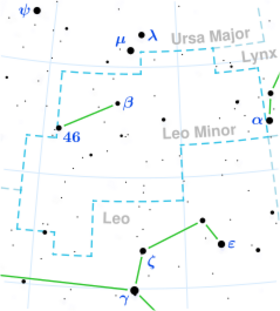Astronomy:41 Leonis Minoris
| Observation data Equinox J2000.0]] (ICRS) | |
|---|---|
| Constellation | Leo Minor |
| Right ascension | 10h 43m 24.95671s[1] |
| Declination | 23° 11′ 18.2499″[1] |
| Apparent magnitude (V) | 5.08[2] |
| Characteristics | |
| Spectral type | A3Vn[3] |
| U−B color index | +0.06[4] |
| B−V color index | +0.04[4] |
| Astrometry | |
| Radial velocity (Rv) | +18.50[5] km/s |
| Proper motion (μ) | RA: -115.30[1] mas/yr Dec.: +7.62[1] mas/yr |
| Parallax (π) | 14.23 ± 0.25[1] mas |
| Distance | 229 ± 4 ly (70 ± 1 pc) |
| Absolute magnitude (MV) | 0.85[2] |
| Details | |
| Mass | 2.47[6] M☉ |
| Radius | 2.1[7] R☉ |
| Luminosity | 55[6] L☉ |
| Surface gravity (log g) | 3.95[8] cgs |
| Temperature | 9,902[8] K |
| Metallicity [Fe/H] | -0.01[9] dex |
| Rotational velocity (v sin i) | 201[6] km/s |
| Age | 182[8] Myr |
| Other designations | |
| Database references | |
| SIMBAD | data |
41 Leonis Minoris is a single[11] star in the northern constellation Leo Minor, located near the southern border with the neighboring constellation of Leo. It is visible to the naked eye as a dim, white-hued star with an apparent visual magnitude of 5.08.[2] This object is located approximately 229 light years away from the Sun, based on parallax,[1] and is drifting further away with a radial velocity of +18.5 km/s.[5]
This is an ordinary A-type main-sequence star with a stellar classification of A3Vn,[3] where the 'n' suffix indicates "nebulous" (broadened) lines due to rapid rotation. It is about 182[8] million years old with a high projected rotational velocity of 201 km/s.[6] The star has 2.5[6] times the mass of the Sun and 2.1[7] times the Sun's radius. It is radiating 55[6] times the luminosity of the Sun from its photosphere at an effective temperature of 9,902 K.[8]
References
- ↑ 1.0 1.1 1.2 1.3 1.4 1.5 Van Leeuwen, F. (2007). "Validation of the new Hipparcos reduction". Astronomy and Astrophysics 474 (2): 653–664. doi:10.1051/0004-6361:20078357. Bibcode: 2007A&A...474..653V. Vizier catalog entry
- ↑ 2.0 2.1 2.2 Anderson, E.; Francis, Ch. (2012). "XHIP: An extended hipparcos compilation". Astronomy Letters 38 (5): 331. doi:10.1134/S1063773712050015. Bibcode: 2012AstL...38..331A. Vizier catalog entry
- ↑ 3.0 3.1 Hoffleit, D.; Warren, W. H. (1995). "VizieR Online Data Catalog: Bright Star Catalogue, 5th Revised Ed. (Hoffleit+, 1991)". VizieR On-line Data Catalog: V/50. Originally Published in: 1964BS....C......0H 5050. Bibcode: 1995yCat.5050....0H.
- ↑ 4.0 4.1 Mermilliod, J. C. (2006). "VizieR Online Data Catalog: Homogeneous Means in the UBV System (Mermilliod 1991)". VizieR On-line Data Catalog: II/168. Originally Published in: Institut d'Astronomie 2168. Bibcode: 2006yCat.2168....0M.Vizier catalog entry
- ↑ 5.0 5.1 Evans, D. S. (1967). "The Revision of the General Catalogue of Radial Velocities". Determination of Radial Velocities and Their Applications 30: 57. Bibcode: 1967IAUS...30...57E.
- ↑ 6.0 6.1 6.2 6.3 6.4 6.5 Zorec, J.; Royer, F. (2012). "Rotational velocities of A-type stars". Astronomy & Astrophysics 537: A120. doi:10.1051/0004-6361/201117691. Bibcode: 2012A&A...537A.120Z. Vizier catalog entry
- ↑ 7.0 7.1 Allende Prieto, C.; Lambert, D. L. (1999). "Fundamental parameters of nearby stars from the comparison with evolutionary calculations: Masses, radii and effective temperatures". Astronomy and Astrophysics 352: 555–562. Bibcode: 1999A&A...352..555A. Vizier catalog entry
- ↑ 8.0 8.1 8.2 8.3 8.4 David, Trevor J.; Hillenbrand, Lynne A. (2015). "The Ages of Early-Type Stars: Strömgren Photometric Methods Calibrated, Validated, Tested, and Applied to Hosts and Prospective Hosts of Directly Imaged Exoplanets". The Astrophysical Journal 804 (2): 146. doi:10.1088/0004-637X/804/2/146. Bibcode: 2015ApJ...804..146D. Vizier catalog entry
- ↑ Gontcharov, G. A. (2012). "Dependence of kinematics on the age of stars in the solar neighborhood". Astronomy Letters 38 (12): 771–782. doi:10.1134/S1063773712120031. Bibcode: 2012AstL...38..771G. Vizier catalog entry
- ↑ "41 LMi". SIMBAD. Centre de données astronomiques de Strasbourg. http://simbad.u-strasbg.fr/simbad/sim-basic?Ident=41+LMi.
- ↑ Eggleton, P. P.; Tokovinin, A. A. (September 2008). "A catalogue of multiplicity among bright stellar systems". Monthly Notices of the Royal Astronomical Society 389 (2): 869–879. doi:10.1111/j.1365-2966.2008.13596.x. Bibcode: 2008MNRAS.389..869E.
 |


